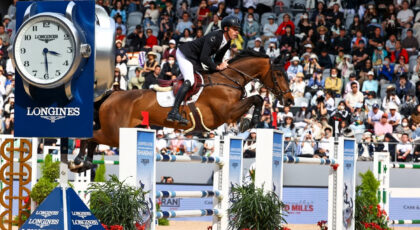At one time or another, most horse-crazy adults can recall being inspired by the wild-maned protagonists of their favorite children’s books: Black Beauty and Sham from King of the Wind; Flicka and Misty of Chincoteague. And yet, for Milanne Rehor, that life-changing moment came in the form of two buried sentences in the 1992 edition of the Yachtsman’s Guide to the Bahamas.
It was a description of the old settlement of Norman’s Castle, a 1929 logging camp on the island of South Abaco, a barrier cay in the northern Bahamas: “Today few traces of the settlement or the industry remain,” the sentence said. “The only inhabitants are herds of wild horses…”
For Rehor, that was all it took.
“My heart nearly stopped when, while planning a sailing trip to Abaco, I read those short sentences. Months later, when I spotted the first, far-off group, I had to fight back tears as I fussed with the manual focus on my old camera. The horses were real. And they were magnificent.”

Nunki, waking up from a nap. (via Arkwild.org)
For more than two decades, Rehor has worked in the service of those horses as president of Arkwild and director of the Wild Horses Of Abaco Preservation Society (W.H.O.A.). She lives on a boat moored to Abaco, and against all odds, continues to work to protect the horses she loves from a variety of forces, both natural and man-made.
The horses Abaco is famous for were imported from Cuba during the late 1800s. But they had already been in the Americas for almost four centuries, as the documented descendants of the original animals bred in Cuba by the Conquistadores. Unlike Cuban horses today, however, the Abaco herds contained none of the 1940s imported stock Cuba used to “improve” its breeding program—meaning the Abaco is essentially a genetic time capsule for Columbus’s original Spanish horses.
Much of this influence can be seen in their appearance. The horses were small, 13-13.2 hands, and renowned for their hardiness, needing only half the food and less water to survive than the typical equine. During the 16th century, they were packed aboard Spanish ships with limited supplies and, upon making land, were forced to jump from the vessels and swim ashore, expected to be ready for whatever lay ahead—be it fighting, overland travel, or dragging trees from newly cleared forests over hilly, rocky ground.

(via Arkwild.org)
“They were the Jeeps of the Spanish army,” Rehor says. “Strong hindquarters, good legs and hooves, and beautifully colored—including sky blue-eyed splash white pintos. They are one of the peak developments of an equine that can do just about anything asked, with good will and steady temperament. They can be funny and clever too.”
For more than a century, the Spanish Abaco horses flourished in the dense pine forests and petrified sand dune hills of Abaco after being abandoned there by logging operations during the early 1900s. As the 20th century progressed, however, their population wavered, falling from 200 to near extinction in the 1970s after they were intentionally exterminated by villagers following the tragic death of a child who tried to ride one.
A rebound of their herds (to nearly 30 horses) was underway in the early 1990s, but by the end of that decade, the Abaco horses were faltering once again, their reproduction halted after the aftermath of Hurricane Floyd. That event, which unleashed a flood of chemicals, herbicides, pesticides and synthetic fertilizers into their formerly pristine environment, would eventually mark the end of the Abaco herds. On July 23, 2015, Nunki, the last remaining wild horse on the island, passed away. But all was not lost.
Tissue samples were collected from Nunki and shipped to ViaGen, an animal cloning technology company in Austin, Texas. “We have been offered $2-3 million dollars in pro bono work from ViaGen, who will provide us with two clones, and from Dr. Robert Smith of the Palm Beach Equine Clinic, which will be donating health care, lab work and support for the establishment of a new herd,” Rehor says.
If successful, the Spanish Abaco clones will be returned to the island and maintained on a 4,000-acre preserve, which Rehor hopes will one day become a world-class destination for locals and visitors, alike; protected as a World Heritage Site by the Bahamas branch of UNESCO.

(via Arkwild.org)
“The goal is to give visitors a taste of the magic that allows 90-foot-tall pine trees to grow with their roots in fresh water, 200 miles out in the ocean. A taste of the magic that allowed some of the more rare and perfect horses on the planet to survive in a harsh environment all on their own, and to bring their heritage into the 21st century for the good of all,” she says.
“We await government approval of our plan to return the horses to Abaco, which was submitted a year ago. We are waiting.”
To follow the progress of the Wild Horses of Abaco, you can like W.H.O.A.’s Facebook page or, to make a donation to support their recovery, click here. 

 November 20, 2016
November 20, 2016 


























